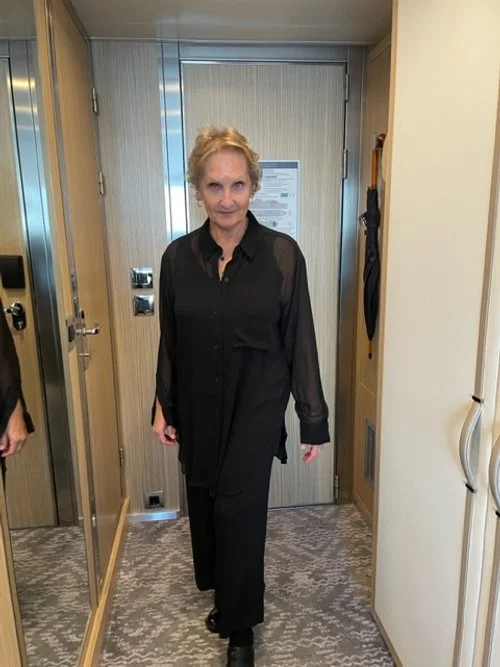We have a couple of sessions a week where a plethora of pickleballers show up and the courts are hopping. There’s no organizer and no plan, which is stressful for me as I do well in a disciplined environment and implode when chaos rules. But I like to play pickleball, so I escape the disarray by focusing on the ball and keeping score, and by playing tunes in my head—show tunes, classical, the top forty for the last fifty years—all stored to be pulled up at any time.
There seems to be an accepted way for women to conduct themselves on the court—women only; men would never behave this way. When someone makes a particularly spectacular shot, arms are thrown in the air and everyone cheers volubly. Joyful shrieks and gambols are involved. When a serve slips by the recipient, the person who lets the ball get past her calls out, “Good serve!” And I think—well, not really, it was just an ordinary serve that you for some reason couldn’t return. Also, every error is relived, sometimes clownishly reenacted, and praised. “Good idea,” a player will say to her partner when a dink hits the net instead of going over; or, “Great effort,” when the ball goes out. Everything on the court is about kindness, encouragement, and enthusiasm. All this baseless exultation is difficult for me to emulate because I’m not a giddy person.
Many of us have similar skill levels, though the tennis players are noticeably better; and occasionally someone shows up who has yet to learn the rules. When another player is extremely superior there’s not just one pickle, but pickle after pickle, which is disheartening. And when a beginner who must be instructed between every play joins us, that, too, is difficult to tolerate. Sadly, sometimes the extreme abilities override the songs in my head and I grumble, wanting everything to be the way I want it to be. That makes me the Trump of the pickleball court.
As you can imagine, in this setting many personalities are involved. In a game last week my partner and I were playing horribly. Every serve was met with an error—net balls, balls out of bounds, serves missed. As our opposing server racked up point after point, I commented to my partner that we were giving points away. The server on the other team, quite peeved, said, “Hey. I’m in the zone and I’m working hard here.” Though it was true that we were handing them the game and I’d heard others say the same thing, in retrospect I could see how it could be considered rude. And she seemed angry about it, so after the match I approached her intending to apologize, and was met with a look of hatred so evil that it gave me chills. “Whoa,” I said, abruptly stepping back. I was so shaken that I gathered my gear and went home. I had nightmares that night.
Another incident that left me shaken was when another player’s dog bit me. It’s not my business that she brings her cute little shiatzu to the court for two hours when the temperature’s already in the high nineties and is going to get hotter. While she prepared the dog’s area—setting out his water and hooking his leash to the fence—she let him run free. As I was passing through, on my way to the courts, the dog jumped up and latched on to my finger, teeth digging in and his whole little body hanging before he fell away. Startled, I gave an “Ow.” Then, in an understandably agitated state, I called to the woman, “Hey, your dog bit me.” By the time I put my racket, visor, and water on a bench, blood was pooling in my palm. Trying to keep it from dripping all over the court, I headed toward the pro shop to beg a band-aide. Meanwhile, the woman had gathered her and her dog’s things and was also aiming toward the exit. Ten feet in front of me, her shoulders were rigid and her fury was palpable. “You don’t need to leave,” I told her. “I’m not mad. I understand dogs.” I also understand that her dog shouldn’t be there, had no desire to be there, and that her bringing him was an act of cruelty. She ignored me, continuing in her forward movement.
If my dog had bitten someone I would have at least called afterward to make sure she was okay. Hell, I’d have sent flowers. But what she did instead is quit coming.
“Did she stop coming because her dog bit me?” I asked one of the other women.
“She thinks you’re a negative force.”
The biting dog woman is popular amongst the other women and now, because of me, she no longer comes. And I am a negative force. It’s a topsy-turvy world.
So my way of handling things with these two enemies I have inadvertently made is to wait until the last minute to put my name on the roster. And if the woman who gave me the evil look has signed up, or if the woman with the dog has signed up, I don’t go to pickleball that day.
Honest to God, it’s junior high all over again.









